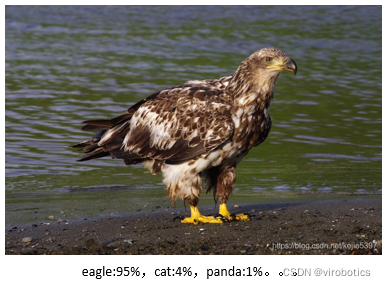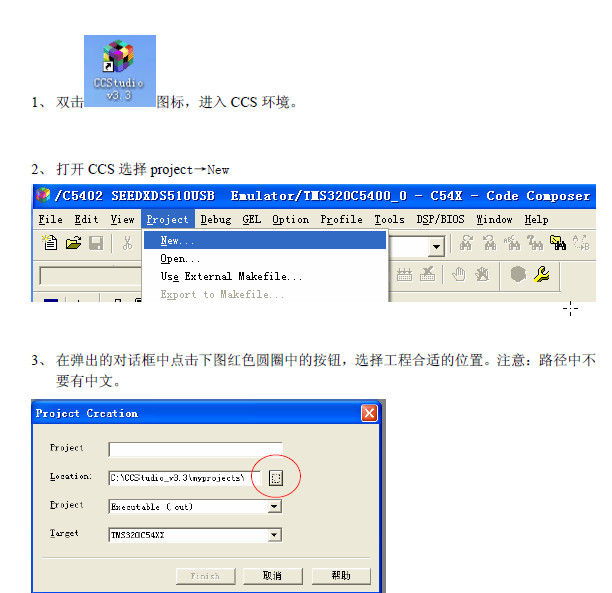前言
上一篇和大家一起分享了如何使用LabVIEW OpenCV dnn實現手寫數字識別,今天我們一起來看一下如何使用LabVIEW OpenCV dnn實現圖像分類 。
一、什么是圖像分類?
1、圖像分類的概念
圖像分類 ,核心是從給定的分類集合中給圖像分配一個標簽的任務。實際上,這意味著我們的任務是分析一個輸入圖像并返回一個將圖像分類的標簽。標簽總是來自預定義的可能類別集。
示例:我們假定一個可能的類別集categories = {dog, cat, eagle},之后我們提供一張圖片(下圖)給分類系統。這里的目標是根據輸入圖像,從類別集中分配一個類別,這里為eagle,我們的分類系統也可以根據概率給圖像分配多個標簽,如eagle:95%,cat:4%,panda:1%

2、MobileNet簡介
MobileNet :基本單元是深度級可分離卷積(depthwise separable convolution),其實這種結構之前已經被使用在Inception模型中。深度級可分離卷積其實是一種可分解卷積操作(factorized convolutions),其可以分解為兩個更小的操作:depthwise convolution和pointwise convolution,如圖1所示。Depthwise convolution和標準卷積不同,對于標準卷積其卷積核是用在所有的輸入通道上(input channels),而depthwise convolution針對每個輸入通道采用不同的卷積核,就是說一個卷積核對應一個輸入通道,所以說depthwise convolution是depth級別的操作。而pointwise convolution其實就是普通的卷積,只不過其采用1x1的卷積核。圖2中更清晰地展示了兩種操作。對于depthwise separable convolution,其首先是采用depthwise convolution對不同輸入通道分別進行卷積,然后采用pointwise convolution將上面的輸出再進行結合,這樣其實整體效果和一個標準卷積是差不多的,但是會大大減少計算量和模型參數量。

MobileNet的網絡結構如表所示。首先是一個3x3的標準卷積,然后后面就是堆積depthwise separable convolution,并且可以看到其中的部分depthwise convolution會通過strides=2進行down sampling。然后采用average pooling將feature變成1x1,根據預測類別大小加上全連接層,最后是一個softmax層。如果單獨計算depthwise convolution和pointwise convolution,整個網絡有28層(這里Avg Pool和Softmax不計算在內)。

二、使用python實現圖像分類(py_to_py_ssd_mobilenet.py)
1、獲取預訓練模型
- 使用tensorflow.keras.applications獲取模型(以mobilenet為例);
from tensorflow.keras.applications import MobileNet
original_tf_model = MobileNet(
include_top=True,
weights="imagenet"
)
- 把original_tf_model打包成pb
def get_tf_model_proto(tf_model):
# define the directory for .pb model
pb_model_path = "models"
?
# define the name of .pb model
pb_model_name = "mobilenet.pb"
?
# create directory for further converted model
os.makedirs(pb_model_path, exist_ok=True)
?
# get model TF graph
tf_model_graph = tf.function(lambda x: tf_model(x))
?
# get concrete function
tf_model_graph = tf_model_graph.get_concrete_function(
tf.TensorSpec(tf_model.inputs[0].shape, tf_model.inputs[0].dtype))
?
# obtain frozen concrete function
frozen_tf_func = convert_variables_to_constants_v2(tf_model_graph)
# get frozen graph
frozen_tf_func.graph.as_graph_def()
?
# save full tf model
tf.io.write_graph(graph_or_graph_def=frozen_tf_func.graph,
logdir=pb_model_path,
name=pb_model_name,
as_text=False)
?
return os.path.join(pb_model_path, pb_model_name)
?
2、使用opencv_dnn進行推理
- 圖像預處理(blob)
def get_preprocessed_img(img_path):
# read the image
input_img = cv2.imread(img_path, cv2.IMREAD_COLOR)
input_img = input_img.astype(np.float32)
?
# define preprocess parameters
mean = np.array([1.0, 1.0, 1.0]) * 127.5
scale = 1 / 127.5
?
# prepare input blob to fit the model input:
# 1. subtract mean
# 2. scale to set pixel values from 0 to 1
input_blob = cv2.dnn.blobFromImage(
image=input_img,
scalefactor=scale,
size=(224, 224), # img target size
mean=mean,
swapRB=True, # BGR -> RGB
crop=True # center crop
)
print("Input blob shape: {}\\n".format(input_blob.shape))
?
return input_blob
- 調用pb模型進行推理
def get_tf_dnn_prediction(original_net, preproc_img, imagenet_labels):
# inference
preproc_img = preproc_img.transpose(0, 2, 3, 1)
print("TF input blob shape: {}\\n".format(preproc_img.shape))
?
out = original_net(preproc_img)
?
print("\\nTensorFlow model prediction: \\n")
print("* shape: ", out.shape)
?
# get the predicted class ID
imagenet_class_id = np.argmax(out)
print("* class ID: {}, label: {}".format(imagenet_class_id, imagenet_labels[imagenet_class_id]))
?
# get confidence
confidence = out[0][imagenet_class_id]
print("* confidence: {:.4f}".format(confidence))
3、實現圖像分類 (代碼匯總)
import os
?
import cv2
import numpy as np
import tensorflow as tf
from tensorflow.keras.applications import MobileNet
from tensorflow.python.framework.convert_to_constants import convert_variables_to_constants_v2
?
?
?
?
def get_tf_model_proto(tf_model):
# define the directory for .pb model
pb_model_path = "models"
?
# define the name of .pb model
pb_model_name = "mobilenet.pb"
?
# create directory for further converted model
os.makedirs(pb_model_path, exist_ok=True)
?
# get model TF graph
tf_model_graph = tf.function(lambda x: tf_model(x))
?
# get concrete function
tf_model_graph = tf_model_graph.get_concrete_function(
tf.TensorSpec(tf_model.inputs[0].shape, tf_model.inputs[0].dtype))
?
# obtain frozen concrete function
frozen_tf_func = convert_variables_to_constants_v2(tf_model_graph)
# get frozen graph
frozen_tf_func.graph.as_graph_def()
?
# save full tf model
tf.io.write_graph(graph_or_graph_def=frozen_tf_func.graph,
logdir=pb_model_path,
name=pb_model_name,
as_text=False)
?
return os.path.join(pb_model_path, pb_model_name)
?
?
def get_preprocessed_img(img_path):
# read the image
input_img = cv2.imread(img_path, cv2.IMREAD_COLOR)
input_img = input_img.astype(np.float32)
?
# define preprocess parameters
mean = np.array([1.0, 1.0, 1.0]) * 127.5
scale = 1 / 127.5
?
# prepare input blob to fit the model input:
# 1. subtract mean
# 2. scale to set pixel values from 0 to 1
input_blob = cv2.dnn.blobFromImage(
image=input_img,
scalefactor=scale,
size=(224, 224), # img target size
mean=mean,
swapRB=True, # BGR -> RGB
crop=True # center crop
)
print("Input blob shape: {}\\n".format(input_blob.shape))
?
return input_blob
?
?
def get_imagenet_labels(labels_path):
with open(labels_path) as f:
imagenet_labels = [line.strip() for line in f.readlines()]
return imagenet_labels
?
?
def get_opencv_dnn_prediction(opencv_net, preproc_img, imagenet_labels):
# set OpenCV DNN input
opencv_net.setInput(preproc_img)
?
# OpenCV DNN inference
out = opencv_net.forward()
print("OpenCV DNN prediction: \\n")
print("* shape: ", out.shape)
?
# get the predicted class ID
imagenet_class_id = np.argmax(out)
?
# get confidence
confidence = out[0][imagenet_class_id]
print("* class ID: {}, label: {}".format(imagenet_class_id, imagenet_labels[imagenet_class_id]))
print("* confidence: {:.4f}\\n".format(confidence))
?
?
def get_tf_dnn_prediction(original_net, preproc_img, imagenet_labels):
# inference
preproc_img = preproc_img.transpose(0, 2, 3, 1)
print("TF input blob shape: {}\\n".format(preproc_img.shape))
?
out = original_net(preproc_img)
?
print("\\nTensorFlow model prediction: \\n")
print("* shape: ", out.shape)
?
# get the predicted class ID
imagenet_class_id = np.argmax(out)
print("* class ID: {}, label: {}".format(imagenet_class_id, imagenet_labels[imagenet_class_id]))
?
# get confidence
confidence = out[0][imagenet_class_id]
print("* confidence: {:.4f}".format(confidence))
?
?
def main():
# configure TF launching
#set_tf_env()
?
# initialize TF MobileNet model
original_tf_model = MobileNet(
include_top=True,
weights="imagenet"
)
?
# get TF frozen graph path
full_pb_path = get_tf_model_proto(original_tf_model)
print(full_pb_path)
?
# read frozen graph with OpenCV API
opencv_net = cv2.dnn.readNetFromTensorflow(full_pb_path)
print("OpenCV model was successfully read. Model layers: \\n", opencv_net.getLayerNames())
?
# get preprocessed image
input_img = get_preprocessed_img("yaopin.png")
?
# get ImageNet labels
imagenet_labels = get_imagenet_labels("classification_classes.txt")
?
# obtain OpenCV DNN predictions
get_opencv_dnn_prediction(opencv_net, input_img, imagenet_labels)
?
# obtain TF model predictions
get_tf_dnn_prediction(original_tf_model, input_img, imagenet_labels)
?
?
if __name__ == "__main__":
main()
?
三、使用LabVIEW dnn實現圖像分類(callpb_photo.vi)
本博客中所用實例基于****LabVIEW2018版本 ,調用mobilenet pb模型
1、讀取待分類的圖片和pb模型

2、將待分類的圖片進行預處理

3、將圖像輸入至神經網絡中并進行推理

4、實現圖像分類

5、總體程序源碼:
按照如下圖所示程序進行編碼,實現圖像分類,本范例中使用了一分類,分類出置信度最高的物體。

如下圖所示為加載藥瓶圖片得到的分類結果,在前面板可以看到圖片和label:

四、源碼下載
鏈接: https://pan.baidu.com/s/10yO72ewfGjxAg_f07wjx0A?pwd=8888
**提取碼:8888 **
審核編輯 黃宇
-
LabVIEW
+關注
關注
1963文章
3652瀏覽量
322399 -
人工智能
+關注
關注
1791文章
46851瀏覽量
237539 -
圖像分類
+關注
關注
0文章
90瀏覽量
11907 -
OpenCV
+關注
關注
30文章
628瀏覽量
41260
發布評論請先 登錄
相關推薦




 手把手教你使用LabVIEW OpenCV dnn實現圖像分類(含源碼)
手把手教你使用LabVIEW OpenCV dnn實現圖像分類(含源碼)












評論